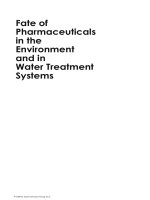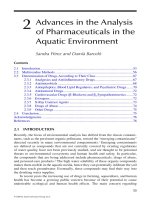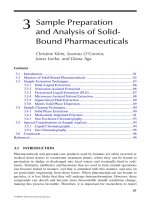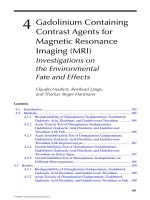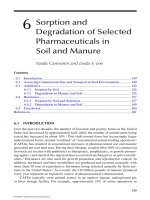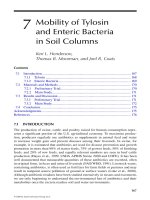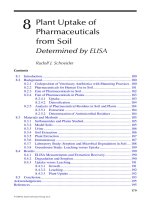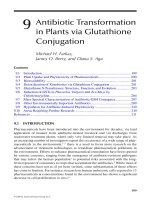Fate of Pharmaceuticals in the Environment and in Water Treatment Systems - Chapter 12 pot
Bạn đang xem bản rút gọn của tài liệu. Xem và tải ngay bản đầy đủ của tài liệu tại đây (440.33 KB, 29 trang )
261
12
Reacti on and
Transformation of
Antibacterial Agents
with Aqueous Chlorine
underRelevantWater
Treatment Conditions
Ching-Hua Huang,
Michael C. Dodd, and Amisha D. Shah
12.1 INTRODUCTION
Each year large quantities of antibacterial agents (referred to as antibacterials here-
after)areusedtotreatdiseasesandinfectionsinhumansandanimals.Applications
ofantibacterialsinhumanmedicinecanultimatelyleadtosignicantdischargesof
Contents
12.1 Introduction 261
12
.2 Background 263
12.2.1 Antibacterial Agents of Investigation 263
12.2.2 Chemical Oxidation by Aqueous Chlorine 267
12.2.3 PriorWorkontheReactionofPharmaceuticalswithChlorine 267
12.3 Materials and Methods 268
12.3.1 Chemica l Reagents 268
12.3.2 Sur fac e Water and Wastewater Samples 269
12.3.3 Reaction Setup and Monitoring 269
12.4 Results and Discussion 271
12.4.1 Reaction Kinetics and Modeling 271
12.4.2 Identication of Reactive Functional Groups 275
12.4.3 React ion Pat hways and Pr oduct s’ Biological Implications 276
12.4.4 Reaction in Real Water Matrices 283
12.5 Conclusion 285
References 285
© 2008 by Taylor & Francis Group, LLC
262 Fate of Pharmaceuticals in the Environment and in Water Treatment Systems
such compounds into surface waters, via excretion of the unmetabolized parent com-
pounds into municipal sewage systems and subsequent passage through municipal
wastewater treatment facilities.
1
In addition, antibacterials are utilized for a number
ofagriculturalapplications,includinguseasgrowthpromotersandfeedefciency
enhancers for livestock
2
and in aquaculture and fruit orchards.
3
It has been estimated
that nearly 50% of the total antibacterial usage in the United States was for agricul-
ture.
4
Signicant proportions of the administered antibacterials can be excreted from
thedosedanimalswithlittlemetabolictransformation.
1,5
Anationwidereconnais-
sancestudypublishedbytheU.S.GeologicalSurvey(USGS)in2002reportedthe
presenceofawidevarietyofchemicalsincludingmanypharmaceuticalsandper
-
sonal-care products in U.S. streams.
6
Other similar ndings regarding the ubiquity
of pharmaceuticals in the aquatic environment have also been reported in the United
Statesandotherpartsoftheworld.
1,7–19
Among the pharmaceuticals, several widely
appliedhuman-useandveterinaryantibacterialclasses,suchasuoroquinolone,sul-
f
o
namide, tetracycline, macrolide, and so forth, have been repeatedly detected in
concentrationsrangingfromlowng/Ltolowµg/L.
6–19
The presence of antibacterial residues in natural surface waters and wastewater
efuentsmeritsconcernforanumberofreasons.First,thecontinuousexposureof
wastewater-borne or environmental bacterial communities to mixtures of antibacterial
residues may promote induction or dissemination of low-level resistant bacterial phe
-
n
o
types,whichhavesignicantindirectimplicationsforhumanhealth.
5,20,21
Second,
studies have shown that, once present in bacterial populations, numerous resistance
phenotypes are stable over many bacterial generations, even in the absence of selec
-
ti
ve pressure from the antibacterial compounds themselves.
22–25
Furthermore, some
antibacterials and their metabolites are reported to exhibit carcinogenic or genotoxic
effects, which may be of direct signicance to human health.
26–28
To properly evaluate
therisksposedbyantibacterialmicropollutants,andtoensureprovisionofsafepota-
b
l
ewatersupplies,thebehaviorofantibacterialsduringrelevantwatertreatmentpro-
c
e
sses should be critically evaluated. Chlorination is an important treatment process
thatislikelytoaffectthefateofnumerousantibacterials,onaccountofitscommon
useinwaterandwastewatertreatmentfordisinfectionpurposes,andbecausemany
antibacterial compounds contain electron-rich functional groups that are susceptible
to reaction with electrophilic chlorine.
This chapter summarizes the authors’ recent contribution to developing a fun
-
damentalunderstandingoftheinteractionsoffourstructuralclasses(quinoxaline
N,N’-dioxide,
29
uoroquinolone,
30
sulfonamide,
31
and pyrimidine
32
)ofantibacterials
with aqueous chlorine under relevant water treatment conditions. In contrast to the
previous publications in which each structural class was dealt with separately, this
chapter discusses these four structural classes simultaneously, highlighting similar
-
i
t
y and difference in their interactions with aqueous chlorine. The investigations
were undertaken to elucidate the chemical reactivity, reaction kinetics, products, and
pathwaysbywhichantibacterialsaretransformedbyfreechlorine.Reactionkinetics
weredeterminedoverawidepHrangeandevaluatedbyasecond-orderkineticmodel
that incorporated the acid-base speciation of each reactant (i.e., oxidant and antibac
-
t
e
rial). Various structurally related compounds that resemble the hypothesized reac-
t
i
ve and nonreactive moieties of the target antibacterials were examined to probe
© 2008 by Taylor & Francis Group, LLC
Reaction and Transformation of Antibacterial Agents with Aqueous Chlorine 263
reactive functional groups. Results obtained from kinetic experiments were supple-
mented by product identication analyses by liquid chromatography/mass spectrom-
et
ry (LC/MS), gas chromatography/mass spectrometry (GC/MS), nuclear magnetic
resonance spectroscopy (
1
H-NMR), and other techniques to facilitate identication
of reaction pathways and mechanisms. Additional experiments were conducted in
real municipal wastewater and surface water matrices to assess the eld-applicabil
-
it
y of observations obtained for reagent water systems in the laboratory.
12.2 BACKGROUND
12.2.1 A
NTIBACTERIAL AGENTS OF INVESTIGATION
Representative antibacterial agents from four structural classes—quinoxaline N,N’-
dioxide, uoroquinolone, sulfonamide, and pyrimidine—were investigated (see
Table 12.1 andT
able 12.2 for the structures of investigated antibacterials and asso-
ciated model compounds). Carbadox (CDX) and olaquindox (QDX) represent the
quinoxaline
N,N’-dioxide g
roup of veterinary antibacterial agents, which are widely
usedinswineproductionforpromotinggrowthandpreventingdysenteryandbacte-
ri
alenteritis.InrecentyearsCDXanditsmajormetabolitedesoxycarbadox(DCDX)
have been shown to exhibit carcinogenic and genotoxic effects.
26–28
Such concerns
ledtheEuropeanUniontobantheuseofCDXinanimalfeedsin1999
33
and Health
CanadatoissueabanonCDXsalesin2001afterreportsofmisuseandaccidental
contamination.
28
Ciprooxacin(CIP)andenrooxacin(ENR)belongtotheuoro-
quinolone structural class, a group of synthetic, broad-spectrum antibacterial agents
that interfere with bacterial DNA replication,
5
andareusedinamultitudeofhuman
and veterinary applications.
2
CIPisoneofthemostfrequentlyprescribedhuman-use
uoroquinolones in North America and Europe,
1
whereasENRwaspopularfordis-
ease prevention and control in the U.S. poultry production industry until recently.
34
Sulfamethoxazole (SMX) is one of the most popular sulfonamide antibacterials used
totreatdiseasesandinfectionsinhumans.
5
Sulfonamides, often referred to as sulfa
drugs, are synthetic antibacterials widely used in human and veterinary medicines
andasgrowthpromotersinfeedsforlivestock.
5
SMXiscommonlyprescribedin
tandem with the synthetic pyrimidine antibacterial trimethoprim (TMP) under the
name cotrimoxazole.
35
These two antibacterials function synergistically as inhibi-
tors of bacterial folic acid synthesis.
5
Recent studies have reported frequent detection of uoroquinolones, sulfon-
amides,andTMPintheaquaticenvironment.Reportedconcentrationsofvarious
uoroquinolonesrangefrom~1to125µg/Linuntreatedhospitalsewage,
10,11
~70
to500ng/Linsecondarywastewaterefuents,
7,14 –16
to~10to120ng/Linsurface
waters.
6,14,15
SMX is the most frequently detected sulfonamide antibacterial at con-
centrationsof70to150ng/Linsurfacewaters
6,12–14
and 200 to 2000 ng/L in second-
ary wastewater efuents.
7,12–14,17
Occurrence of TMP was reported at several-hundred
ng/L in secondary municipal wastewater efuents,
18,19
and at concentrations from
approximately10toseveral-hundredng/Linsurfacewaters,
12,17
particularly those
receiving substantial discharges of treated wastewater.
8
Concentrations of CDX in
surfacewatersandwastewaterswerereportedintwostudiestobebelowthedetec-
ti
onlimitsof0.1µg/Land5ng/L,respectively.
6,17
© 2008 by Taylor & Francis Group, LLC
264 Fate of Pharmaceuticals in the Environment and in Water Treatment Systems
TABLE 12.1
Structures and Apparent Second-Order Rate Constants (k
app
)for
Reactions of CIP, ENR, SMX, CDX, and Related Model Compounds
with FAC at pH 7–7.2 and 25°C
Compound k
app
(M
-1
s
-1
) Compound k
app
(M
–1
s
–1
)
CDX
N
+
N
+
N
H
NO
O
O
–
O
–
1.3 × 10
4
CIP
N
OH
O
N
HN
O
F
6.5 × 10
5
Desoxy-CDX
N
N
N
H
NO
O
2.3 × 10
3
ENR
N
F
O
OH
O
N
N
5.3 × 10
2
ODX
O
H
N
OH
N
+
N
+
O
–
O
–
~0
FLU
F
O
N
OH
O
~0
QDX
N
+
O
–
N
+
O
–
~0
SMX
S
NH
O
O
N
O
NH
2
1.5 × 10
3
QXO
N
N
+
O
–
~0
MMIB
S
NH
O
O
N
O
~0
QNO
N
+
O
–
~0
APMS
S
O
O
NH
2
1.1 × 10
2
DMI
N
O
~0
QDX = Quindoxin
QXO = Quinoxaline N-oxide
QNO
= Quinoline N-oxide
FLU = Flumequine
MMIB = 4-Methyl-N-(5-methyl-isoxazol-3-yl)-benzenesulfonamide
APMS = 4-aminophenyl methyl sulfone
DMI = 3,5-dimethylisoxazole
© 2008 by Taylor & Francis Group, LLC
Reaction and Transformation of Antibacterial Agents with Aqueous Chlorine 265
As shown in Figure 12.1,eachoftheseantibacterialscontainsacidicorbasic
functional groups in their structures that undergo proton exchange in aqueous sys-
tems.CDXandDCDXeachcontainahydrazoneside-chain,inwhichanN-Hgroup
can deprotonate with an estimated pK
a
of 9.6 for CDX (by Strock et al. using Che-
maxon).
36
AsillustratedbyCIP,uoroquinolonesexhibitpH-dependentspeciation
in cationic, neutral, zwitterionic, or anionic forms. Because the neutral and zwitter-
ionic microspecies are often difcult to distinguish by simple potentiometric titra-
tion techniques, macroscopic constants K
a1
and K
a2
are often used to describe the
equilibrium between the cationic and neutral/zwitterionic forms and the equilibrium
between the neutral/zwitterionic and anionic forms, respectively. Although the mac-
roscopicconstantisnotforaparticularfunctionalgroup,literaturehaslinkedK
a1
to the carboxylate group and K
a2
to the piperazinyl N4 atom of uoroquinolones
because of similar pK
a
values to those of monofunctional analogs.
37
Although not
shown,ENR’spHspeciationpatternissimilartothatofCIPwithreportedpK
a1
and
pK
a2
values at 6.1 and 7.7, respectively.
38
Sulfonamides contain two moieties con-
nected by way of the characteristic sulfonamide linkage (-NH-S(O
2
)-); the aniline
moiety in para-connectiontothesulfonylSiscommonamongalmostallsulfon-
amides,andavarietyofdifferentstructuresmaybeconnectedtothesulfonamide
N.
5
Sulfonamides exhibit two acid dissociation constants: one involving protonation
TABLE 12.2
Structures and Apparent Second-Order Rate
Constants (k
app
) for Reactions of Trimethoprin
(TMP) and Related Model Compounds with Free
Available Chlorine (FAC) at 25°C
Compound k
app
(M
–1
s
–1
)
TMP
N
N
NH
2
NH
2
O
O
O
14.2 (pH 4)
48.1 (pH 7)
0.78 (pH 9)
TMT
O
O
O
59.8 (pH 4)
3.22 (pH 7)
0.24 (pH 9)
DAMP
N
N
NH
2
NH
2
0.46 (pH 4)
23.9 (pH 7)
0.77 (pH 9)
TMT = 3,4,5-trimethoxytoluene
DAMP = 2,4-diamino-5-methylpyrimidine
© 2008 by Taylor & Francis Group, LLC
266 Fate of Pharmaceuticals in the Environment and in Water Treatment Systems
N
+
N
+
N
H
NO
O
O
–
O
–
N
+
N
+
N
–
NO
O
O
–
O
–
H
N
O
OH
O
F
N
N
S
NH
3
+
H
N
N
O
O
O
S
NH
2
H
N
N
O
O
O
S
NH
2
–
N
N
O
O
O
NH
+
NH
2
NH
2
O
O
O
H
+
N
N
NH
2
NH
2
O
O
O
H
+
N
HN
N
O
O
–
O
F
N
H
2
N
+
N
O
O
–
O
F
N
or
Sulfamethoxazole (SMX)
NH
+
NH
2
NH
2
O
O
O
H
+
N
N1
N3
Trimethoprim (TMP)
H
2
N
+
N4
N
O
OH
O
F
N
N1
Ciprofloxacin (CIP)
pK
a
Carbadox (CDX)
9.6
a
pK
a1
6.2
b
8.8
b
pK
a2
5.6
c
pK
a2
pK
a1
1.7
c
pK
a1
3.2
d
pK
a2
7.1
e
FIGURE 12.1 Structures and pH speciation of representative antibacterial agents. (a) Reference 36; (b)Reference37;(c)Reference39;(d)Reference
40;and(e)Reference41.
© 2008 by Taylor & Francis Group, LLC
Reaction and Transformation of Antibacterial Agents with Aqueous Chlorine 267
of the aniline N and the other corresponding to deprotonation of the sulfonamide
N.
39
TMPcanundergoprotonationattheheterocyclicN1andN3nitrogenatoms
contained within its 2,4-diamino-5-methylpyrimidinyl moiety, leading to positively
charged species at circumneutral to lower pHs.
40,41
Aswillbediscussedinthischap-
ter, variations in acid-base speciation of these antibacterial agents under environ-
mentally relevant conditions strongly affect their reactivity with aqueous chlorine.
12.2.2 CHEMICAL OXIDATION BY AQUEOUS CHLORINE
Aqueous chlorine (HOCl / OCl
-
)isanimportantdrinkingwaterdisinfectantandis
used in both drinking water and wastewater treatment to achieve chemical oxida-
ti
on of undesirable taste-, odor-, and color-causing compounds and reduced inor-
ganic species.
42,43
Aqueous chlorine is typically present either as hypochlorous acid
(HOCl) or its dissociated form, hypochlorite ion (OCl
–
),atpH>5(Equation12.1),
andmayformmolecularCl
2(aq)
atverylowpHorhighCl
–
concentrations (Equation
12.2) . The combination of these aqueous chlorine species (generally only HOCl +
OCl
-
under typical water treatment conditions) is referred to as free available chlo-
rine (FAC) hereafter in this chapter.
HOCl OCl
–
+H
+
pK
a
=7.4–7.5(at25°C)
44,45
(12.1)
Cl
2
+H
2
OHOCl+Cl
–
+H
+
K=5.1×10
–4
M
2
(at 25°C)
46
(12.2)
In recent decades the electrophilic character of aqueous chlorine has drawn sub-
stantial attention due to reactions with natural organic matter (NOM), leading to the
formation of harmful chlorinated disinfection byproducts (DBPs) (e.g., trihalometh-
an
es [THMs] and haloacetic acids [HAAs]).
42
Substrates such as NOM are readily
oxidized,sincetheyconsistoforganicmoleculeswithelectron-richsitesthatare
susceptible toward electrophilic attack. The reaction mechanisms of aqueous chlo-
ri
newithNOMarecomplexandmayinvolveoxidationwithoxygentransferand
substitutions or additions that lead to chlorinated byproducts.
42,47
The above reac-
tionsmaythenbefollowedbyanumberofnonoxidationprocesses,suchaselimina-
tion, hydrolysis, and rearrangement reactions,
42
further complicating the range of
byproducts generated.
Synthetic organic compounds such as antibacterials can be considered targets
for transformation by aqueous chlorine. Since many antibacterials possess structural
moietiesandfunctionalgroupsthatareelectronrich,suchasactivatedaromaticrings
and amines (as seen in Figure 12.1), chemical t
ransformation of these compounds
duringchlorinetreatmentislikely.Therateandextentofsuchreactions,aswell
as the byproducts formed, will be highly dependent on the antibacterials’ chemical
properties, the applied chlorine dose, and water conditions such as pH, temperature,
and concentrations and types of dissolved organic or inorganic species.
12.2.3 PRIOR WORK ON THE REACTION OF PHARMACEUTICALS WITH CHLORINE
Prior studies indicate that a number of pharmaceuticals are highly susceptible toward
chlorine oxidation and are readily transformed under various drinking water and
wastewater conditions. Thus far, studies have either assessed particular groups of
© 2008 by Taylor & Francis Group, LLC
268 Fate of Pharmaceuticals in the Environment and in Water Treatment Systems
pharmaceuticals that exhibit biological activity (e.g., endocrine disruptors,
48,49
C-
blockers,
50
analgesics,
50
and antibiotics
51,52
), or have focused on the detailed reactivity
of individual compounds (e.g., 17 C-estradiol,
53
acetaminophen,
54
naproxen,
55
caf-
feine,
56
and triclosan
57
). In many of these studies, laboratory-scale experiments were
conducted by assessing the removal of spiked pharmaceuticals by aqueous chlorine
in synthetic water or waters taken from water treatment plants or natural rivers. One
particular study examined a large number of pharmaceuticals in which degradation
variedgreatly(<10to>90%)afteraninitialchlorinedoseof2.8to6.75mg/LasCl
2
,
a24-hcontacttime,andasolutionpHof5.5.
58
Concentrations of pharmaceuticals in
full-scaletreatmentplantsbeforeandafterchlorinationwerealsomonitoredinorder
to evaluate the removal of these compounds by chlorine.
7
In many of these stud-
ies, reaction kinetics were examined in synthetic waters to determine whether the
selectedcompoundswerelikelytobecompletelydepletedduringcontacttimestypi
-
ca
lofdrinkingwaterandwastewatertreatment.Inlimitedcases,byproductanalyses
were conducted to assist in determining whether reaction products could potentially
retain the biological activity of the corresponding parent compounds.
53
Compared to the broad range of pharmaceuticals detected in surface waters,
drinking water supplies, and wastewaters, the number of pharmaceutical compounds
that have been investigated in depth regarding the mechanisms and products of their
transformation by chlorine is still quite limited. A fundamental understanding of the
reactions of pharmaceuticals with chlorine is critical because it enables identication
of reactive functional groups/structural moieties and creates the basis for predicting
the fate of other emerging contaminants on the structural basis. For example, many of
thetargetpharmaceuticalcompoundscontainaromaticfunctionalgroupswithelec
-
tr
on-donating substituents (e.g., substituted phenols and aromatic ethers)
48,50,53,54,57
that are known to react readily with chlorine.
59
In a study addressing chlorination of
natural hormones (17C-estradiol,
estrone, estriol, and progesterone) and one synthetic
hormone (17B-ethinylestradiol), a
ll molecules with a phenolic group were rapidly
oxidized (t
1/2
=6to8minatpH7,[chlorine]
0
=1mg/LasCl
2
), whereas progesterone,
whichlacksaphenolicgroup,remainedunchangedover30mininthepresenceof
excess chlorine.
49
Another study addressing chlorination of analgesics found that all
such compounds containing aromatic ether substituents were reactive toward excess
chlorine, whereas those lacking such substituents (e.g., ibuprofen and ketoprofen) did
notshowanysignicantlossesover5days.
50
Amine-containing compounds such as
several C-blockershavealsobeenshown
to be reactive toward chlorine.
51
In this chapter recent contributions by the authors toward elucidating the kinetics
andtransformationpathwaysoffourstructuralclassesofantibacterials(quinoxaline
N,N’-dioxide,
uoroquinolone, sulfonamide, and pyrimidine) in reactions with free
chlorine are discussed.
29–32
Signicantly, these studies on the reactions of antibacte-
rialswithfreechlorineareamongtherstconductedinsuchdetail.
12.3 MATERIALS AND METHODS
12.3.1 C
HEMICAL REAGENTS
Theformsandcommercialsourcesofthetargetantibacterialsandstructurally
related model compounds were described previsouly.
29–32
DCDX, quindoxin (QDX),
© 2008 by Taylor & Francis Group, LLC
Reaction and Transformation of Antibacterial Agents with Aqueous Chlorine 269
and quinoxaline N-oxide (QXO) were synthesized by methods described previ-
ously.
60
All commercial chemical standards were of >97% purity and used without
further purication. NaOCl was obtained from Fisher Scientic at ~7% by weight.
Allotherreagentsused(e.g.,buffers,colorimetricagents,reductants,solvents,etc.
from Fisher Scientic or Aldrich) were of at least reagent-grade purity. Stock solu
-
ti
onsofantibacterialsandmodelcompoundswerepreparedat25to100mg/Lin
reagent water (from a Barnstead or a Millipore water purication system) with 10 to
50%(v/v)methanol.FACstocksat0.1to1g/LasCl
2
were prepared by dilution of
7%NaOClsolutionsandstandardizediodometrically
61
or spectrophotometrically.
46
12.3.2 SURFACE WATER AND WASTEWATER SAMPLES
Secondary wastewater efuent samples (collected after activated sludge processes
and prior to disinfection) were obtained from pilot-scale or full-scale domestic waste-
wat
ertreatmentplantsinAtlantaandZurich.Surfacewatersampleswerecollected
from the Chattahoochee River in Atlanta—near the intake of a regional drinking
water treatment plant, and from Lake Zurich in Switzerland—at the intake of one
of Zurich’s drinking water treatment plants. Samples were ltered through 0.45-µm
lters,storedat4to6°C,andusedwithin2daysofcollection.Importantcharac
-
teristicsofthesesamplesweredeterminedbystandardmethodsorprovidedbythe
facilities where samples were taken, as summarized in
Table 12.3.
12.3.3 REACTION SETUP AND MONITORING
Batch Reactions: For slower reactions, batch kinetic experiments were conducted in
25-mL amber glass vials at pH 3–11 under continuous stirring at 25°C. Reactions
werebufferedusing10to50mMacetate(pH4to5.5),phosphate(pH6to8),or
TABLE 12.3
Surface Water (SW) and Wastewater (WW) Sample
Characteristics
Sampling Site pH Alkalinity
(mg/L, as CaCO
3
)
NH
3
(mg NH
3
-N/L)
DOC*
(mg/L as C)
Atlanta WW 7.3 120 < 0.12
a
14.0
Zurich WW 1 8.3 143 0.013 5.6
Zurich WW 2 8.1 500 1.5 12.3
Atlanta SW 1 6.6 13 < 0.12
a
1.3
Atlanta SW 2 7.2 n.a. n.a. 2.8
Lake Zurich SW 1 8.4 126 0.0068 1.6
Lake Zurich SW2 8.1 135 0.019 1.7
a
Minimum detectable concentration was ~ 120 µg/L NH3-N (~ 7 × 10-6 mol/L)
n.a. = not available
*
DOC = dissolved organic carbon
© 2008 by Taylor & Francis Group, LLC
270 Fate of Pharmaceuticals in the Environment and in Water Treatment Systems
tetraborate(pH9to11).Theinitialconcentrationoftestcompoundswastypically1
to 10 µM for kinetic studies. Reactions were initiated by adding excess (10×) molar
amounts of FAC compared to the target compound. For SMX, 4-aminophenyl methyl
sulfone (APMS), TMP, and 2,4-diamino-5-methylpyrimidine (DAMP), sample ali-
quotswereperiodicallytakenandquenchedbya“soft”quenchingtechnique—using
NH
3
as a reductant—to minimize potential reversal conversion of reaction interme-
diates(e.g.,N-chlorinatedSMX)backtotheparentcompounds.
31
For the other com-
pounds,samplealiquotswereperiodicallytakenandquenchedwithexcessNa
2
S
2
O
3
.
Pseudo-rst-order rate constants, k
obs
,werecalculatedfromlinear(0.95>r
2
>1)
plots of ln([antibacterial]) vs. time. Experiments to monitor the reaction rates of anti-
bacterials with chlorine in real water samples were conducted by similar procedures
used to measure rate constants in reagent water matrix. In these cases, FAC was
added at concentrations at least tenfold greater than the corresponding antibacterial
concentrations.
Competition Kinetics:ThereactionsofCDXandDCDXwithFACatpH>5and
thereactionofCIPwithFACatpH4,5,6,10,and11weretoofasttomonitorby
batchtechniques.Instead,twocompetitionkineticsmethodswereutilizedforthese
measurements.InthemethodutilizedforCDXandDCDX,theantibacterialanda
selected competitor (with known k
app
) were added at equimolar concentrations to
batch reactors at various pHs. Varying substoichiometric amounts of free chlorine
were then added. Sample aliquots were taken after each reaction was completed and
analyzed for the concentrations of remaining antibacterial and the competitor. Plot-
ting the data according to the following linear relationship allows determination of
the second-order rate constant of the antibacterial:
ln
[]
[]
,
,
competitor
competitor
T
Tt
app
k
0
¥
§
¦
´
¶
µ
ccompetitor
app
antibacterial
k
s ln
[antibacteri
aal
antibacterial
]
[]
,
,
T
Tt
0
¥
§
¦
´
¶
µ
(12.3a)
where [competitor]
T,t
and [antibacterial]
T,t
represent the remaining reactant concen-
trationsafteraspecicsubstoichiometricdoseofFAChasbeenadded.4,6-Dichlo-
roresorcinol, with known k
app
values reported in Rebenne et al.,
62
wasselectedasthe
competitorforCDX.OncetherateconstantforCDXwasdeterminedateachpH,
CDX was used as the competitor for DCDX.
In the method utilized for CIP, the antibacterial and the competitor 4,6-dichlo-
roresorcinol were added to vials at varying molar ratios of competitor to antibacte-
rialoverarangeofpHvalues.Axedsubstoichiometricdoseoffreechlorinewas
thenaddedunderrapidmixingtoeachvial.Aftercompleteconsumptionoffree
chlorine,1-mLsamplealiquotsweretransferredtoamber,borosilicatehigh-per-
formance liquid chromatography (HPLC) vials, quenched with Na
2
S
2
O
3
to prevent
reactions of the competitor with a N-chlorinated intermediate formed upon reac-
tionofCIPwithfreechlorine,andstabilizedwith~0.1MH
3
PO
4
prior to analysis
by HPLC with uorescence detection. Apparent second-order rate constants for the
reactionofCIPwithFACatdifferentpHweredeterminedbymonitoringyields
of a product (presumably 2,4,6-trichloresorcinol) formed upon chlorination of the
© 2008 by Taylor & Francis Group, LLC
Reaction and Transformation of Antibacterial Agents with Aqueous Chlorine 271
competitor, 2,4-dichloresorcinol, and plotting measured product yields according to
Equation 12.3b:
product
product
absence
presence
¨
ª
·
¹
¨
ª
·
¹
1
k
appp
competitor
T
app
antibacter
k
competitor
¨
ª
·
¹
,0
iial
T
antibacterial
;=
,0
(12.3b)
where [product]
absence
represents product yield in the absence of CIP [product]
presence
represents product yields in the presence of varying CIP concentrations, and
[competitor]
T,0
and [antibacterial]
T,0
represent reactant concentrations before addi-
tion of FAC.
Continuous-Flow Method: FA
C decay was measured under pseudo-rst-order
conditions in the presence of a large excess of CIP, at pH ranging from 5–11, by
a continuous-ow, quenched-reaction method described previously.
30
Pseudo-
rst-order rate constants, k
obs
,werecalculatedfromlinear(0.97>r
2
> 1) plots of
ln([FAC]) vs. time.
Reactant and Reaction Product Analyses: Pa
rent compound loss was monitored
byreverse-phaseHPLCwithultraviolet(UV),uorescence,ormassspectrometry
detection. Reaction intermediates and products were analyzed using reverse-phase
HPLC/electrospray MS techniques. Details of the HPLC and MS instrumental condi
-
tions were described previously.
29–32
Residual oxidant concentrations were measured
at the conclusion of each kinetic experiment by N,N-diethyl-p-phenylenediamine
(
DPD) colorimetry or DPD-ferrous ammonium sulfate (FAS) titrimetry.
61
12.4 RESULTS AND DISCUSSION
12.4.1 R
EACTION KINETICS AND MODELING
Foralloftheantibacterialsexamined,reactionswerefoundtoberstorderwith
respecttotheantibacterialandFACandsocanbedescribedbyageneralsecond-
orderrateexpression:
d
dt
k
obs
Antibacterial
Antibacterial
T
T
;=
;=
kk
app
FAC Antibacterial
TT
;=; =
(12.4)
where k
obs
(in s
-1
)istheobservedpseudo-rst-orderrateconstant,Trepresentsthe
sumofallacid-basespeciesforagivenreactant,andk
app
(in M
-1
s
-1
)isthepH-depen-
dent apparent second-order rate constant for the overall reaction, which can be cal-
cu
lated from
k
k
app
obs
;=
FAC
T
.
Kinetic experiments revealed a marked dependence of k
app
values on pH (Fig-
ure 12.2). The v
ariation in k
app
frompH4to11canbeattributedtothevarying
importance of specic reactions among the individual acid-base species of FAC and
antibacterials. The acid-base speciation of FAC (i.e., Equation 12.1) and antibacterials
© 2008 by Taylor & Francis Group, LLC
272 Fate of Pharmaceuticals in the Environment and in Water Treatment Systems
pH
(a)
2 4 6 8
10 12
pH
(b)
2 4 6 8
10 12
Mole Fraction
0.0
0.2
0.4
0.6
0.8
1.0
Mole Fraction
0.0
0.2
0.4
0.6
0.8
1.0
pH
(c)
2 4 6 8
10 12
Mole Fraction
0.0
0.2
0.4
0.6
0.8
1.0
log k
app
(M
–1
s
–1
)
k
app
(M
–1
s
–1
)
k
app
(M
–1
s
–1
)
0
1
2
3
4
5
Competition Kinetics
Batch
Model k
app
CDX
CDX
–
HOCl
OCl
–
10
3
10
4
10
5
10
6
10
7
Continuous Flow
Competition
Kinetics
Model k
app
CIP Cation
Neutral/
Zwitterionic
CIP
CIP Anion
HOCl
OCl
–
10
0
10
1
10
2
10
3
Meas. k
app
Model k
app
ENR Cation
Neutral/
Zwitterionic
ENR
ENR Anion
HOCl
OCl
–
pH
(d)
2 4 6 8 10 12
pH
(e)
2 4 6 8 10 12
Mole Fraction
0.0
0.2
0.4
0.6
0.8
1.0
Mole Fraction
0.0
0.2
0.4
0.6
0.8
1.0
k
app
(M
–1
s
–1
)
k
app
(M
–1
s
–1
)
10
0
10
1
10
2
10
3
0.0
5.0e + 2
1.0e + 3
1.5e + 3
2.0e + 3
2.5e + 3
Meas. Rate Constant
Calc. Rate Constant
SMX
Cation
SMX
Neutral
SMX
Anion
HOCl
OCl
–
Meas. k
app
Model k
app
TMP
+
HOCl
OCl
–
TMP
TMP
++
FIGURE 12.2 EffectofpHontheapparentsecond-orderrateconstantsforthereactionsof(a)CDX,(b)CIP,(c)ENR,(d)SMX,and(e)TMP.(Adapted
from Reference 29 through Reference 32.)
© 2008 by Taylor & Francis Group, LLC
Reaction and Transformation of Antibacterial Agents with Aqueous Chlorine 273
(i.e., Figure 12.1)canbemodeledaccordingtomassbalancerelationshipsandknown
acid-base equilibria:
FAC HOCl OCl FAC
T
-
=1,2
T
;=
;=
;=
;=
¤
A
i
i
(12.5)
Antibacterial Antiba
T
j=1,2 or j=1,2,3
;=
¤
B
j
ccterial
T
;=
(12.6)
where
A
1
[H ]
[H ]
a,HOCl
K
for HOCl and
A
2
K
K
a,HOCl
a,HOCl
[H ]
for OCl
-
,
B
1
[H ]
[H ]
a
K
and
B
2
K
K
a
a
[H ]
formonoproticantibacterialCDX,and
B
1
[H ]
[H ] [ H ]
2
2
a1 a1 a2
KKK
,
B
1
[H ]
[H ] [ H ]
2
2
a1 a1 a2
KKK
,
B
2
K
KKK
a1
2
a1 a1 a2
[H ]
[H ] [ H ]
and
B
3
KK
KKK
a1 a2
2
a1 a1 a2
[H ] [ H ]
fordiproticantibacterialsCIP,ENR,SMXandTMP.
IncorporatingEquation12.5andEquation12.6intoEquation12.4canderiveEqua-
ti
on 12.7,
kk
app ij i j
¤
AB
i 1,2
j 1,2 or j 1,2,3
(12.7)
where k
ij
represents the specic second-order rate constants for reactions of
each oxidant species i with e
ach antibacterial species j.Notethatforuoroqui-
nolones, the zwitterionic and neutral species are combined as a single “effec-
ti
ve” monoprotonated species (according to macroscopic pK
a1
and pK
a2
values)
because reliable equilibrium constants are not available for the microspeciation
of CIP and ENR.
As shown in Figure 12.2,
k
app
decreases sharply at pH greater than or equal to
7forallofthecompounds.Thedecreaseink
app
canbeattributedtodeprotonation
of HOCl to yield OCl
–
, which is generally a much weaker electrophile than HOCl.
63
This indicates that reactions among OCl
-
and various antibacterial species are rela-
tivelyunimportantandcanbeomittedfromEquation12.7(asshownbyEquation
12.8 through Equation 12.13 in Table 12.4). Further simplication of the kinetic
equation can be conducted for the reactions of CDX and SMX with HOCl, respec
-
ti
vely.ForCDX,thereactionwithHOClappearstobedominatedbythedeproton-
ate
dCDXspecies(CDX
-
),andthereactionofneutralCDXwithHOClisnegligible
(i.e., Equation 12.8) because: (i) the experimental k
app
valuescanonlybettedif
the neutral CDX species’ specic rate constant (i.e., k
11
ismanuallyassignedavery
small value or omitted, and (ii) the k
app
exhibits a well-dened bell-shaped pH pro-
le(Figure12.2a)andreachesamaximumatthepHneartheaverageofthepK
a
s
© 2008 by Taylor & Francis Group, LLC
274 Fate of Pharmaceuticals in the Environment and in Water Treatment Systems
ofHOClandCDX.ForSMX,thereactionofHOClwiththecationicformofSMX
(SMX
+
)isneglected(i.e.,Equation12.11)onthebasisoftwoassumptions:(i)the
abundance of SMX
+
is rather low within the pH ranges studied (pK
a
for the aromatic
amineis1.7,whichis2.3pHunitslowerthanthelowestpHvaluestudied),and(ii)
protonationoftheaniline’sprimaryaminogroupshouldattheveryleastretard(if
notprevent)thereactionbetweenHOClandSMXbycoordinatingthelone-pair
electrons associated with this nitrogen.
For TMP, reactivity trends above pH 5 were similar to those observed for each of
the other three antibacterial classes. However, in this case,
k
app
increases substantially
with increasing acidity at pH below 5. This trend indicates that factors other than
acid-basespeciationofTMPandHOClareplayingaroleingoverningthekinetics
of this reaction, as protonation of TMP should yield less nucleophilic species, which
should in turn be less reactive toward electrophilic chlorine. One possible explanation
for these observations is an acid-catalyzed reaction between HOCl and TMP’s 3,4,5-
trimethoxybenzyl moiety (i.e.,
), in parallel
to trends previously observed for various phenols and methoxybenzenes.
50,57,59,62
Accordingly, an acid catalysis term (
k
H
H
¨
ª
·
¹
)canbeaddedtoEquation12.7to
yieldEquation12.12inTable 12.4. Alternatively, t
he increase in reaction rate at pH
TABLE 12.4
Kinetic Models for the Reaction of Antibacterial Agents with FAC
Compound
Kinetic Model for the Apparent
Second-Order Rate Constant k
app
(M
–1
s
–1
)
Carbadox (CDX)
kk
app CDX,
12 1 2
AB
(12.8)
Ciprooxacin (CIP)
kk kk
app CIP,
11 1 1 12 1 2 13 1 3
AB AB AB
+
(12.9)
Enrooxacin (ENR)
kk kk
app ENR,
11 1 1 12 1 2 13 1 3
AB AB AB
+
(12.10)
Sulfamethoxazole (SMX)
kkk
app SMX,
12 1 2 13 1 3
AB AB
(12.11)
Trimethoprim (TMP)
kk kkk
app,TMP
H
H
¨
ª
·
¹
11 1 1 12 1 2 13 1 3
AB AB AB
(12.12)
kk
K
app,TMP Cl
Cl ,hydrol
2(aq)
2
Cl H
¨
ª
·
¹
¨
ª
·
¹
A
1
yysis
kk k
11 1 1 12 1 2 13 1 3
AB AB AB
(12.13)
The mathematic expressions of B and C values are discussed in the text.
For TMP: k
H+
(in M
–2
s
–1
) represents the rate constant for the acid-catalyzed reaction between HOCl and
TMP, k
Cl2(aq)
(in M
–1
s
–1
) represents the apparent second-order rate constant for the bulk reaction of
Cl
2(aq)
with all three TMP species, and is the equilibrium constant for the hydrolysis
of Cl
2(aq)
(Equation 12.2).
© 2008 by Taylor & Francis Group, LLC
Reaction and Transformation of Antibacterial Agents with Aqueous Chlorine 275
<5couldbeattributabletogenerationofmolecularchlorine,Cl
2(aq)
, at increasing
acidities,
57,64
via the equilibrium represented by Equation 12.2. In this case, a term
(
k
K
Cl
Cl ,hydrolysis
2(aq)
2
Cl H
A
1
¨
ª
·
¹
¨
ª
·
¹
)forthebulkreactionofCl
2(aq)
with all three TMP species (i.e.,
TMP Cl products
aq
Cl
hydrogen
} m}}}}
2
2
()
,
k
)canbeaddedtoEquation12.7toyieldEquation
12.13.
The
kinetic models for each of the above reactions were tted to experimental
data using nonlinear Marquardt-Levenberg regression (SigmaPlot 2002, SPSS Soft
-
wa
re). As shown in Figure 12.2, these k
inetic models describe the experimental data
measuredforeachantibacterialverywell.InthecaseofTMP,thetwoalternative
models presented above (using an estimated [Cl
–
]=1.7×10
–5
MforEquation12.13)
appeared to be quite similar and resulted in a nearly perfect overlap. However, based
on evidence presented by Cherney et al. on the role of Cl
2(aq)
in acidic chlorination
reactions,
64
thelattermodelmaybemoreplausible.
Alloftheantibacterialsreactedfairlyquicklywithaqueouschlorineat
circumneutral pH values. Based on the
k
app
values obtained (Table 12.1 and
Table 12.2), the h
alf-lives(pH7to7.2,25°C)ofCDX,CIP,ENR,SMX,and
TMPat2.5mg/LasCl
2
of [FAC]
0
areestimatedtobe1.5s,0.03s,37.1s,13.1s,
and 6.8 min, respectively. These estimates indicate that substantial transforma-
ti
on of each antibacterial by aqueous chlorine can be expected during contact
timestypicalofdrinkingwater(1to17h)
65
and wastewater (30 to 120 min)
66
treatment.
12.4.2 IDENTIFICATION OF REACTIVE FUNCTIONAL GROUPS
Thekineticmodelsdiscussedaboveprovideusefultoolsforevaluatingtheimpor-
tanceofeachantibacterialandoxidantspeciesinthekineticsobservedforeach
reaction and facilitate determination of reactive sites within each antibacterial
structure. The experimental data suggest that attack of CDX, CIP/ENR, SMX,
and TMP by free chlorine is closely related to protonation and deprotonation of
their hydrazone linkage, piperazinyl N4 atom, anilinyl amino group, and 2,4-
diamino-methylpyrimidinyl moiety, respectively. A clear inverse relationship
between the reaction rate and the degree of protonation of the aforementioned
functional groups is demonstrated i
nFigure1
2.2. Such trends are consistent
with the expectation that protonation leads to a decrease in reactivity of various
functional groups toward free chlorine.
To verify reactive functional groups, examination of model compounds that
resemble the hypothesized reactive and nonreactive moieties of each antibacterial
initsreactionswithchlorinewasconducted,inadditiontostructuralanalysisof
each antibacterial’sreactionintermediatesandproducts.AsshowninTable12.1and
Table12.2,arangeofmodelcompoundswascarefullyselectedandexaminedfor
eachantibacterialstructuralclass.TheresultsshowninTable12.1indicatethatboth
CDXandDCDXreactwithchlorineatcomparablerates,whereasODX,QX,QDX,
QXO,andQNOdonotreactatpH7.1to7.4forupto1to2hoursunderexcessfree
© 2008 by Taylor & Francis Group, LLC
276 Fate of Pharmaceuticals in the Environment and in Water Treatment Systems
chlorineconditions,conrmingthatthe hydrazone side-chainisthereactivesiteand
thequinoxaline N,N ´-dioxidea
ndquinoxalinemoietiesarerelativelyinerttochlo-
rine.TheresultsthatbothCIPandENRarereactivetochlorine;thatthereactivity
ofCIPisaboutthreeordersofmagnitudehigherthanthatofENR;andthatFLU,
whichlacksthepiperazinering,doesnotreactwithchlorineclearlydemonstratethe
criticalroleofthe
piperazinyl N4 ato
minthereactionwithchlorine.Thecompari-
sonamongSMX,MMIB,APMS,andDMIveriesthatthe anilinyl amino gr
oup
isrequiredforthereactionwithchlorine.Table 12 .2 shows
that both DAMP and
TMT—the two model compounds selected to evaluate the TMP structure’s reactiv-
it
y—arereactivetochlorine,butexhibitsignicantlydifferentpH-dependencyin
their reactivities toward free chlorine. Like TMP, DAMP is most reactive toward
chlorine at pH 7, and the magnitudes of
k
app,DAMP
atpH7and9comparefavorably
with those of k
app,TMP
. However, unlike TMP, DAMP exhibits very low reactivity
toward chlorine at pH 4. In contrast, TMT reacts rapidly with chlorine at pH 4 but
exhibits much decreased reactivity with increasing pH. This comparison strongly
supports that TMP’s
3,4,5-trimethoxybenzyl m
o
iety is primarily responsible for the
observed increase in reaction rate at acidic pH, whereas the 2,4-diamino-methyl-
pyrimidinyl mo
ietygovernsTMP’sreactivityatintermediateandalkalinepH.
12.4.3 REACTION PATHWAYS AND PRODUCTS’ BIOLOGICAL IMPLICATIONS
Extensive efforts using LC/MS, GC/MS,
1
H-NMR, and other techniques were made
toidentifythemostprobablestructuresofreactionintermediatesandproducts.Evo-
lu
tion of reaction intermediates and products over time was also monitored. These
results were combined with the results of reaction kinetic modeling and reactive site
identicationtodeducethepathwaysbywhichtheantibacterialsaretransformedin
their reactions with FAC. Details of product characterization and determination of
reactionpathwaysareomittedhereforthesakeofbrevityandcanbefoundinthe
previous publications.
29–32
TheproposedpathwaysforreactionsofFACwithCDX,
CIP, ENR, SMX, and TMP (Scheme 12.1 through Scheme 12.5) are discussed briey
below along with possible biological implications of the reaction products.
CDX:
D
eprotonationofthehydrazoneN-Happarentlyresultsinanegative
charge that substantially enhances reactivity of CDX toward electrophilic chlorine.
ThereactionbeginswithaninitialHOClattackatthehydrazoneN
C
of the negatively
charged CDX
–
,leadingtoareactiveN-chlorointermediate(Scheme12.1).Atacidic
to slightly basic conditions, the imine carbon of the N-chloro intermediate is suscep-
ti
bletointramolecularnucleophilicattack(bytheoxygenoftheH-carbonyl g
roup)
orbimolecularnucleophilicattackbyconstituentsofthewatermatrix(e.g.,OH
–
,
CH
3
COO
–
,andCl
–-
), to yield various nucleophile-parent adducts. Hydroxylated
products (i.e., m/z M+16) r
esulting from bimolecular nucleophilic substitution may
graduallydecay.AspHincreases,themuchstrongerOH
-
nucleophile plays an
increasingly greater role in product formation. At alkaline pH (8.9 to 9.0) and upon
further excess chlorine oxidation, either the attack of the N-chloro intermediate by
two OH
-
or attack of the hydroxylated product (i.e., m/z M+16)byoneOH
–
can
yieldanazoxyproduct(i.e., m/z M
+ 30).
© 2008 by Taylor & Francis Group, LLC
Reaction and Transformation of Antibacterial Agents with Aqueous Chlorine 277
The antibacterial activity of CDX rests on the presence of the N-oxide groups
which impair DNA synthesis by forming a radical upon N-oxide r
eduction.
67,68
How-
ever, the CDX N-oxide m
oietywasnottransformedduringreactionwithFAC,and
allproductsformedretainthisfunctionalgroup.Theseresultsimplylittlecompro-
mi
se in CDX’s antibacterial activity by reaction with chlorine, irrespective of the
rapidkineticswithwhichtheCDXstructureistransformedinthisreaction.
CIP and ENR:R
eactionofCIPwithFACproceedsprimarilythroughaninitial
attack of HOCl on CIP’s piperazinyl N4 atom, leading to the unstable intermedi-
ate
, CIP-Ia1, which subsequently decays via
pi
perazine ring fragmentation to the
product CIP-Pa1 (Scheme 12.2). In the presence of excess chlorine, CIP-Pa1 reacts
further via N-chlorination followed by decay in water to yield the fully dealkylated
products(CIP-Pa2andCIP-Pa3).BecauseoftheN4andsecondaryN1amines’pre
-
su
mablyhighreactivitytowardchlorine,
69,70
addition of Cl to the aromatic system
ofCIPisonlylikelytooccurunderconditionsforwhichchlorinationoftheamines
is unfavorable, namely, when they are protonated (e.g., in cationic CIP) or already
chlorinated(e.g.,inCIP-Ib1).
AlthoughENRdiffersfromCIPonlywithrespecttodegreeofN4aminealkyla
-
ti
on in the structures, it exhibits markedly different chlorine reaction pathways. As
showninScheme12.3,initiallyHOClalsoattacksthetertiaryN4amineofENR
(butatamuchslowerratethanthatwithCIP),forminganapparentlyhighlyreactive
N
NH
O
O
Nu
Ar
N
N
O
O
Nu
Ar
–Cl
–
Ar
O
O
N
N
N
N
O
O
Ar
Cl
– HCl
+HOCl
–OH
–
N
N
O
O
Ar
Cl
N
+
N
+
N
–
NH
O
O
O
–
O
–
+2 HOCl
–2 HCl
–H
20
+OH
–
–Cl
–
N
+
N
+
O
–
O
–
NH
NH
O
O
Ar
N
NH
2
Ar
CDX (M)
Nb
N
N
+
O
O
Ar
O
–
O
Na
N
N
O
O
Ar
OH
+2 HOCl
–2 HCl
–H
20
N
+
N
+
N
NH O
O
O
–
O
–
Ar =
*Structures shown in () are proposed intermediates
and not analytically observed.
Intramolecular
Nucleophilic
Attack
ACIDIC/NEUTRAL
CONDITIONS
Nu
–
*most likely found in water
*only for OH
–
or H
2
O as Nu:
–
*
O
*
M-2
M + 30
ALKALINE
CONDITIONS
m/z 205
Further Decomposition
Nu:
–
OH
–
or H
2
O
Excess
–OC(O)CH
3
Excess Cl
–
m /z
M+16
M+58
iM+34
Nucleophilic
Attack
SCHEME 12.1 ProposedreactionpathwaysforCDXwithfreeavailablechlorine.(Adapted
from Reference 29.)
© 2008 by Taylor & Francis Group, LLC
278 Fate of Pharmaceuticals in the Environment and in Water Treatment Systems
HOCl
N
OH
O
N
+
H
2
N
+
H
2
N
O
F
N
OH
O
N
HN
O
F
N
OH
O
N
O
F
Cl
CIP (Ciprofloxacin)
HOCl
Reductant
N
OH
O
N
N
O
F
Cl
N
OH
O
N
N
O
F
Cl
Cl
N
OH
O
HN
H
2
N
O
F
Cl
HOCl
a
HOCl
2 Cl
3Cl
N
OH
O
HN
H
2
N
O
F
N
OH
O
HN
H
2
N
O
F
N
OH
O
HN
H
2
N
O
F
HOCl
HOCl
H
2
O
H
2
O
H
2
O
N
OH
O
H
2
N
O
F
N
OH
O
H
2
N
O
F
Cl
HOCl
CIP-Ia2
CIP-Ia3
CIP-Pa3
CIP-Pa2
CIP-Ia1
CIP-Pb1
pK
a2
CIP-Pc1
H
2
O, –HCl,
–2 CH
2
O
CIP-Ib1
b
CIP-Pa1
H
2
O
~ 100% yield at
circumneutral pH
SCHEME 12.2 ProposedpathwaysforreactionsofCIPwithfreeavailablechlorine.(a)PathwaynotlikelytobeimportantexceptatveryhighFAC
concentrations.(b)CIP-Ib1structurewasproposednot explicitly observed. (Adapted from Reference 30.)
© 2008 by Taylor & Francis Group, LLC
Reaction and Transformation of Antibacterial Agents with Aqueous Chlorine 279
SCHEME 12.3 ProposedpathwaysforreactionsofENRwithfreeavailablechlorine.(a)Directhalogenationandautotransformationpathwayspresum-
ably apply to all four ENR acid-base species. (b) Catalytic autotransformation pathways should be suppressed by the presence of R
3
N(4)Cl
+
-scavenging
substrates in real water reaction matrixes. (Adapted from Reference 30.)
A
R
N
N
+
Cl
F
O
N
OH
O
R
N
N
F
O
N
Cl
N
O
F
B
ENR (Enrofloxacin)
a
FLU (Flumequine)
or other R
3
N(4)Cl
+
-
scavenging substrates
FLU-P or other
halogenated products
ENR-P3
R
3
N(4)Cl
+
HOCl
or
c
k
app
˝
ENR-P2
N
OH
O
N
N
O
F
or ENR-P2
HOCl
R =
where, for ENR: A = H, B = COOH
for ENR-P1: A = H, B = Cl
for ENR-P2: A = Cl, B = COOH
for ENR-P3: A = Cl, B = Cl
R
3
N(4)Cl
+
R
3
N(4)Cl
+
or
HOCl
k
auto
˝
k
cat´
´
OH
–
Auto-
transformation
Scavenging
Direct
Halogenation
N
OH
O
N
N
O
F
Cl
ENR-P1
N
Cl
N
N
O
F
N
Cl
N
N
O
F
Cl
(a)
(b)
© 2008 by Taylor & Francis Group, LLC
280 Fate of Pharmaceuticals in the Environment and in Water Treatment Systems
o+
"3,(
'
o+,.',.
-,.
1,'
('.
130,0
N+,.'(
+,.'(
.,(.,-.
6
6
6
6
%+(
(',.0
NN,+,.'(
p+323'
#
$&
5! 3,(
'0
%+(
(',.0
/,.*
(',.0
-,.
40)'-(+2'4(
+(
,-(,
/3-(,
/0
SCHEME 12.4 Proposed pathways for reactions of SMX with free available chlorine. Structures enclosed in brackets are given as probable intermedi-
ates.(a)EstimatedyieldobtainedfromdatareportedbyReference73.(AdaptedfromReference31.)
© 2008 by Taylor & Francis Group, LLC
Reaction and Transformation of Antibacterial Agents with Aqueous Chlorine 281
N
N
O
O
O
NH
2
H
2
O
(p
H 7
)
H
+
HOCl
N
N
O
O
O
NH
2
N
H
N
NH
2
O
O
O
NH
2
HOCl, H
2
O
H
+
(pH 4)
HOCl
N
N
NH
2
O
O
O
NH
2
X
X
HOCl, H
2
O
N
+
H
N
O
O
O
NH
2
NH
2
X
X
pK
a2
= 7.1
1
2
3
4
5
6
1'
2'
3'
4'
5'
6'
X = 3 Cl + 1 OH + 1 H for m/z 411
X = 4 Cl + 1 OH for m/z 445
X = 1 Cl + 1 H for m/z 325
X = 2 Cl for m/z 359
X
n
X
n
SCHEME 12.5 ProposedmajorproductsandtransformationpathwaysforthereactionofTMPwithfreeavailablechlorine.(AdaptedfromReference
32.)
© 2008 by Taylor & Francis Group, LLC
282 Fate of Pharmaceuticals in the Environment and in Water Treatment Systems
chlorammonium intermediate (R
3
N(4)Cl
+
) that can catalytically halogenate ENR
or other substrates present in solution. FLU, which exhibits no apparent reactivity
toward HOCl, was found to undergo facile halodecarboxylation in the presence of
R
3
N(4)Cl
+
species derived from ENR. Details for determination of this mechanism
are described in Dodd et al.
30
These results with CIP and ENR demonstrate the two
very different transformation pathways and kinetic trends that should be expected
for secondary versus tertiary amine-containing uoroquinolones in reaction with
chlorine.
T
he
ability of uoroquinolones to inhibit bacterial DNA replication and repair is
believed to be linked to their quinolone moieties,
71
suggesting that CIP’s predominant
transformation pathway (i.e., piperazine fragmentation) may not lead to complete
eliminationofantibacterialactivity.Accordingly,evenquinolonestructureswhich
lack the piperazine ring (e.g., nalidixic acid) can be active against various types of
bacteria.
72
Direct halogenation ortho- to the piperazine ring is also unlikely to result
incompleteeliminationofquinoloneactivity,assuggestedbytheconsiderableanti-
b
a
cterial potency of lomeoxacin,
72
which is substituted by a uorine atom in the
same position. Although modication of ENR’s quinolone moiety via halodecarboxy-
lation (Scheme 12.3) might interrupt the charge interactions and hydrogen-bonding
required for quinolone-DNA binding, this reaction may be relatively unimportant in
realwaters(duetothepresenceofscavengersfortheR
3
N(4)Cl
+
intermediate of ENR
in natural waters). On the basis of these observations, one can infer that a major-
i
t
y of the transformation products likely to result from passage of uoroquinolones
through water chlorination processes could remain biochemically active.
SMX:
T
hereactionofSMXandFACbeginswithaninitialattackofHOClonthe
anilinylaminoNofSMX(Scheme12.4).Underconditionswhere[FAC]
0
:[SMX]
0
<1,theN-chlorinatedSMXslowlyrearrangestoyieldortho-
chlorination o
fSMX’s
aniline
73
orrevertstotheparentSMXstructure.When[FAC]
0
:[SMX]
0
>1 (i.e.,
excess chlorine), further chlorination of N-
chlorinated S
MX is believed to lead to
formation of a N,N-
dichlorinated S
MX intermediate, which subsequently decays via
facile cleavage of the S-C bond to yield the N-chlorimine NCBQ (N-chloro-p-benzo-
q
u
inoneimine), as well as AMI (3-amino-5-methylisoxazole) and SO
2
.
The antibacterial activity of SMX is derived from its antagonistic competition
with
p-aminobenzoicacidfordihydropteroatesynthaseenzyme,whichisnecessary
for bacterial folic acid synthesis.
74
Accordingtothismodeofactivity,sulfonamide
activityisderivedfromthecharacteristicanilinylmoiety.Inconsiderationofthe
reactionpathwaysidentiedforSMX,thecriticalroleoftheanilinylmoietyimplies
that SMX/FAC reaction will likely contribute to at least partial reduction or elimina
-
t
i
onofSMX’santibacterialactivity,sincethesepathwaysleadtoextensivedisruption
of the sulfonamide structure. However, the effects of aromatic ring-chlorination—in
which the
p-
aminobenzenesulfonamide s
tructure is essentially conserved—are less
clear. Furthermore, other products formed in this reaction, particularly, N-chloro-p-
b
e
nzoquinoneimine (NCBQ), might possess higher acute toxicity
75
to aquatic organ-
isms than the parent substrates.
TMP:Asdescribedintheprevioussection,thetwoaromaticmoietiesofTMP
eachreactwithFAC,butwithmarkedlydifferentpHdependency.AtacidicpH,
HOCl attacks TMP’s 3,4,5-trimethoxybenzyl moiety, leading to sequential mono-
© 2008 by Taylor & Francis Group, LLC
Reaction and Transformation of Antibacterial Agents with Aqueous Chlorine 283
anddichlorinationofthetrimethoxybenzylring(Scheme12.5).Inthepresenceof
excess chlorine, slower halogenation of the dihalogenated product’s protonated 2,4-
diaminopyrimidinylmoietycanapparentlyoccurtoyieldthetetrahalogenatedreac
-
ti
on product (m/z 445). A
tintermediatetoalkalinepH,HOClreactsprimarilywith
TMP’s2,4-diamino-methylpyrimidinylmoiety,byhalogenationoroxidation,toyield
awiderangeofCl-andOH-substitutedproducts.Slowhalogenationoftheseprod
-
uc
ts’ 3,4,5-trimethoxybenzyl moiety may occur in the presence of excess chlorine.
ItisevidentfromthesendingsthattheTMPstructureisnotsubstantially
degraded upon reactions with FAC. Instead, a wide variety of (multi)chlorinated
andhydroxylatedproductsareformed.Theeffectsofsuchringsubstitutiononthe
TMP’santibacterialactivityarenotcurrentlyclear,suggestingtheneedforaddi
-
ti
onalbiologicalstudiesdesignedtoevaluatethechlorinatedproducts’activities.
12.4.4 REACTION IN REAL WATER MATRICES
Additional experiments were conducted to validate the applicability of measured
FAC reaction kinetics to modeling reactions in real municipal wastewater and sur-
fa
ce water samples (Table 12.3).Re
actionsofENRandSMXinrealwatersamples
weremodeledbyassumingtwodifferentreactionsteps:onecharacterizedbyrapid
decayofFACduringtherst10s(duetorapidconsumptionbyhighlyreactive
substratessuchasphenols,reducedsulfurcompounds,amines,etc., inthewater
samples),andonebyslowerFACdecayduringtheremainingreactiontime.FAC
decayduringthetworeactionperiodswastreatedaspseudo-rst-order,andwas
modeledusingFACresidualmeasurementstakenatvarioustimeintervalsduring
theexperimentalmonitoringperiods.ENRandSMXlosseswereinturnmodeled
byinsertingmodeledFACconcentrationsintopseudo-rst-orderexpressionsfor
antibacteriallosses.ObservedoxidationkineticsforSMXlosscorrespondedquite
closelytothosepredictedonthebasisofreactionkineticsmeasuredincleanwater
systems(Figure 12.3a). RatesofENRtransformationweremoderatelyslowerin
environmentalmatricesthanpredictedonthebasisofreactionkineticsmeasured
incleanwatersystems(Figure12.
3b). As d
iscussed in the previous section, ENR
reacts with HOCl via formation of a highly reactive chloroammonium intermediate
(R
3
N(4)Cl
+
). The slower rate of ENR reaction with FAC in the real water experi-
mentsmatricesislikelydueinparttosuppressionofENRauto-transformationby
R
3
N(4)Cl
+
-scavenging substrates such as NOM present in the real water matrices.
TheinitialreactionofCIPwithFACinrealwatermatriceswastoorapidtofol-
lo
wdirectly.However,thekineticsofitspiperazinering’sfragmentationcouldbe
evaluatedindirectlybymonitoringlossoftheN-chlorinatedintermediateofCIP
(i.e.,CIP-Ia1inScheme12.2).Modelresultsconrmedtheapplicabilityofthekinet
-
ics measured in clean water systems to the real water samples (Figure12 .
3c). Details
of these measurements and the corresponding model evaluation can be referred to
Dodd et al.
30
For real water experiments involving TMP, the FAC loss to matrix constitu-
entsovertimewasalsomodeledusingrst-orderdecayconstantsfromtwosepa-
rat
ekineticregimesinthedrinkingwaterandthreeseparatekineticregimesin
the wastewater. The equations describing FAC’s pseudo-rst-order decay were then
© 2008 by Taylor & Francis Group, LLC
284 Fate of Pharmaceuticals in the Environment and in Water Treatment Systems
inserted into a pseudo-rst-order expression for TMP loss and integrated (see the
detailed descriptions in Dodd and Huang
32
)topermitmodelingofTMPlossover
time. As shown in Figure12.3 d
,TMPdepletionratesinthedrinkingwatermatrix
could be accurately described. However, model predictions substantially underes-
ti
matedtherateofTMPlossduringchlorinationofthewastewatermatrix.Ade-
ni
teexplanationforthisdiscrepancyisnotcurrentlyavailable,althoughitdoesnot
appeartobeduetoanychangeinreactionmechanism,asproductformationinthe
realwaterswassimilartothatobservedinreagentwatersystems.Additionalstudies
with a wider range of wastewater matrices would be necessary to more thoroughly
evaluate the effect of wastewater composition (and perhaps individual wastewater
constituents) on the magnitude of these deviations from predicted TMP loss rates.
Inanycase,theratesatwhichTMPwasoxidizedineachrealwatersampleindicate
that substantial losses of the parent compound can be expected for residence times
typicalofdrinkingwaterandwastewaterdisinfectionprocesses.
CDXwasassessedforitsreactionratewithFACinasurfacewatersample
(Atlanta SW2,
Table 12.3) under c
onditionsofexcessfreechlorine(10×[CDX]
0
)
andwasfoundtoundergocompletetransformationinlessthan30s(i.e.,thepar-
en
tCDXwasnotdetectableafter30s).Althoughthereactionratewastoofastto
Measured (Wastewater)
1.0
0.8
0.6
0.4
C/C
0
0.2
0.0
1.0
0.8
0.6
0.4
C/C
0
0.2
0.0
0 20406080
0.0 0.00.5 1.0
Time (min)
(a)
Time (min)
(c)
1.0
0.8
0.6
0.4
C/C
0
0.2
0.0
02010 4030 50 60
Time (min)
(d)
1.5 2.0
1.0
0.8
0.6
0.4
C/C
0
0.2
0.0
0.5 1.0
Time (min)
(b)
1.5 3.02.52.0
Modeled (Wastewater)
Measured (Surface Water)
Modeled (Surface Water)
Modeled (Wastewater)
Modeled (Surface Water)
Measured (Wastewater)
Measured (Surface Water)
Modeled (Wastewater)
Modeled (Surface Water)
Measured (Wastewater)
Measured (Surface Water)
Measured (Wastewater)
Measured (Surface Water)
Sulfamethoxazole
CIP-ia1
Enrofloxacin
Trimethoprim
FIGURE 12.3 Reactionsofantibacterialswithchlorineovertimeinrealwatermatrices.
Realwatersamples:SMX(AtlantaWW;AtlantaSW1);ENR(ZurichWW1;LakeZurich
SW1);CIP(AtlantaWW;AtlantaSW1);TMP(ZurichWW2;LakeZurichSW2).(Adapted
from Reference 30 through Reference 32.)
© 2008 by Taylor & Francis Group, LLC
Reaction and Transformation of Antibacterial Agents with Aqueous Chlorine 285
monitor accurately by batch methods, these results conrmed the expectation that
CDXwillberapidlytransformedduringchlorinationofrealwatermatrices.
In addition to kinetic evaluation, reaction product identities and evolution pat-
ternsforthetargetantibacterialsintheenvironmentalmatrixexperimentswere
foundtobesimilartothoseobservedinthecleanwatersystems.Overall,realwater
studies conrmed that the laboratory observations obtained from reagent water sys-
tems can be applied with reasonable accuracy for modeling antibacterial loss rates in
real waters under realistic treatment conditions.
12.5 CONCLUSION
Carbadox (CDX), ciprooxacin (CIP) and enrooxacin (ENR), sulfamethoxazole
(SMX), and trimethoprim (TMP) represent four structural classes (quinoxaline
N,N’-dioxide,uoroquinolone,sulfonamide,andpyrimidine)ofwidelyusedanti-
bacterial agents, respectively. In assessing the susceptibility of the above antibacteri-
al
s toward reactions with chlorine under typical water chlorination conditions, this
study focused on obtaining a fundamental understanding of the reaction kinetics,
products, and mechanisms between free available chlorine (FAC, i.e., HOCl/OCl
–
)
and antibacterials. Overall, the reaction kinetics are highly pH-dependent and can
be successfully described using a second-order kinetic model that incorporates the
acid-base speciation of reactants. The estimated half-lives of the four antibacterials
rangedfrom1.5sto6.7minunderconditionstypicalofdrinkingwatertreatment
conditions(i.e.,at2.5mg/LasCl
2
of FAC, pH 7, and 25°C). Studies conducted in
realwastewaterandsurfacewatermatricesconrmthatrapidtransformationofthese
antibacterials can be expected during contact times typical of drinking water (1 to
17 h) and wastewater (30 to 120 min) chlorination. Notably, structural identication
of many reaction products of antibacterials in this study provides critical informa-
tionforassessingthepotentialbiologicalactivityoftransformationproductsthatare
also likely present in nished drinking water and surface streams due to discharged
wastewater efuent. Through a combination of effective research methodologies, the
reactive sites and reaction mechanisms via which the antibacterials react with free
chlorine were elucidated. The obtained fundamental knowledge can be applied to
many other antibacterial compounds in the similar structural classes and also pro-
vides the basis for predicting the fate and transformation of other structurally related
organic contaminants during water chlorination processes.
REFERENCES
1. Daughton, C.G. and Ternes, T.A. Pharmaceuticals and personal care products in the
environment: agents of subtle change? Environ. Health Perspectives, 1
07, 907, 1999.
2. National Research Council. The Use of Drugs in Food Animals,N
ational Academy
Press, Washington, D.C., 1999.
3. NASS, National Agricultural Statistics Service. Agricultural Chemical Usage, Fruit,
and Nut Summary 1999,
USDA Economics and Statistics System, 2000.
4. Mellon, M., Benbrook, C., and Benbrook, K.L. Hogging It. Estimates of Antimicrobial
Abuse in Livestock,
Union of Concerned Scientists Publications, 2001.
© 2008 by Taylor & Francis Group, LLC
